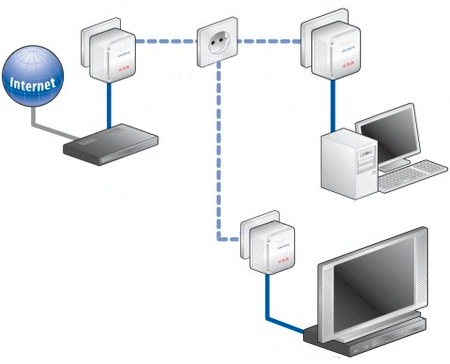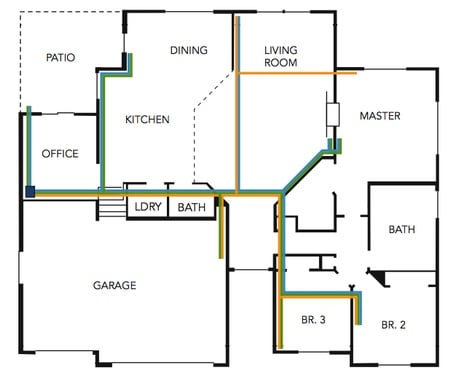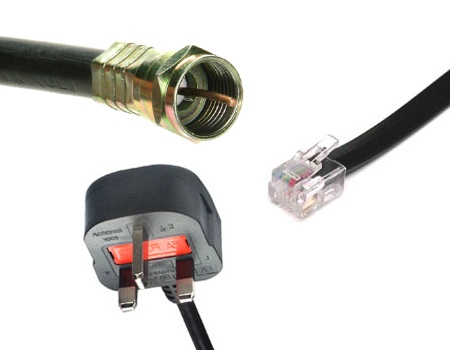Original URL: https://www.theregister.com/2009/02/27/g_hn_and_p1901_future_of_home_lans/
G.hn-ing for gigabit
How the next-gen home LAN standard war was won
Posted in Personal Tech, 27th February 2009 12:20 GMT
It's surely no coincidence that shortly after one technology for high-speed home networking achieved a key step toward becoming a world standard, the minds behind an alternative approach said they too had finally got the ball rolling.
It won't do it much good - the second would-be standard, IEEE P1901, is arguably doomed, a victim of a standards war in which only one shot has been fired.
Early in December 2008, the International Telecommunication Union (ITU) gave its thumbs-up to G.hn, a proposed standard for domestic networks over a range of different cable types. G.hn's goal is to unite coax, phone lines and mains cabling into a single network capable of hosting multiple HD streams over gigabit bandwidths around the home.

Powerline today: battleground for two rival technologies
Image courtesy Devolo
The ITU's backing - its "Consent" in the formal language employed by the organisation - centres on the G.hn physical signalling sub-system, the PHY. G.hn developers still have to finalise the MAC layer - the bit that handles the exchange of meaningful data - but ratification of the physical layer is the major milestone to pass, since vendors can now get on with designing and building kit.
The technology's being backed by almost two-dozen manufacturers and by organisations who've thus far promoted networking over one of those three links. So, powerline networking proponent the Universal Powerline Association (UPA) has joined up with the Home Phone Networking Alliance (HomePNA) to support a technology that will bring their respective worlds together.
But just as UPA has spent the last few years slugging it out with the rival powerline specification pushed by the HomePlug Alliance (HPA), each to position its preferred technology as the de facto standard for networking devices over mains wiring, so G.hn has an apparent competitor: the IEEE's P1901 initiative.
P1901 was established in June 2005 to define a standard way to link homes to broadband service providers over powerlines, but has since brought in-home powerline networking into its remit too. Both HomePlug and the UPA - effectively, its main backer, Spanish powerline chip maker DS2 - joined in and proposed their respective powerline technologies for P1901's LAN component.
So did Panasonic, which pushes powerline in Japan through its HD Power Line Communications (HD-PLC) subsidiary, but after many months in which P1901 members couldn't agree on which proposal to use, it teamed up with HomePlug to propose a combined technology compatible with both.
Panasonic's initial proposal was also supported by Japan's Consumer Electronics Powerline Communication Alliance (CEPCA), which counts pretty much all the major local CE companies among its members. It's since become a major G.hn proponent.
HD-PLC and HomePlug submitted their joint proposal in September 2007. It won an initial vote the following month, but that verdict wasn't ratified by gaining a clear, 75 per cent majority at subsequent ballots. That happened many times last year, until the various parties finally chose to agree on the HD-PLC/HomePlug technology on 22 December 2008, when the P1910 working group finally ended up with a baseline specification from which the technology can evolve and proceed eventually through the IEEE ratification process to become a standard.
Interestingly, to get to that stage, the group had to agree to include compatibility with G.hn, which had reached a similar stage earlier that month. G.hn compatibility was mandated by the UPA crowd and, as we'll see, it could well prove a canny move that effectively renders P1901 irrelevant.
On first impressions, though, the move to support G.hn would appear to favour P1901 in a new, broader standards race - it has the broadest array of technology on board. However, P1901 is arguably a flawed design since it incorporates multiple, incompatible PHY specifications. That would be fine if vendors will be obliged to include all of the standard's PHYs, but they're not, they can pick and choose.

G.hn: different cabling types - but one network
The upshot is that if manufacturer A uses one PHY, and manufacturer B uses another, their products will not work together - despite both being compliant with P1901 and sporting whatever Wi-Fi-style brand products based on the standard end up being sold under.
And it's not like 802.11a, 802.11b and 802.11g where there are clear differences - speed and backwards compatibility - between them.
It gets worse. P1901 also takes in multiple MACs rather than a single specification that can operate with all of the PHYs. This only increases the opportunity for interoperability problems.
P1901 has long had this dual-PHY, dual-MAC approach, but the decision to incorporate G.hn compatibility has only complicated matters, by including the need for a third PHY and MAC pairing.
Contrast that with G.hn, which incorporates just a single PHY for all three transport systems it operates over and, in turn, one MAC.
It's telling that Wi-Fi didn't gain mass industry support until the specification's four initial PHYs had been whittled down to one. And it's that simplicity that has turned many a vendor on to G.hn, along with its support for all three key home wiring systems.
The way around P1901's PHY and MAC incompatibilities is for manufacturers to build devices that support them all, but this requires more components, increasing the cost of the final products. G.hn holds open the prospect that a single chip will be able to manage whichever ports a device contains, making it cheaper from the outset and easier to integrate into devices from PCs to set-top boxes. The way chip production processes shrink over time means a single-chip P1901 implementation will one day be possible, but G.hn will have one heck of a lead.
Most likely, it won't need it. The inclusion of G.hn support in P1901 means that its backers have a way out of a standards war. Build a device that's G.hn compatible and - thanks to that single PHY - it'll be physically interoperable with all the others. But even if said device lacks P1901's other PHYs, the vendor will still be able to claim IEEE 1901 compatibility.
Honour will be satisfied - especially, if seems a distinct possibility, P1901 fades away as it's increasingly overshadowed by the less complex, more comprehensive - and now no longer entirely incompatible - G.hn.
Japan's CEPCA, HD-PLC and UPA are all already well engaged with the G.hn development process, and this week said they'd be joining with the HomeGrid Forum to promote the technology. HomeGrid is G.hn's answer to the Wi-Fi Alliance, and will in due course be overseeing device interoperability testing.
Of course, G.hn is not compatible with existing powerline networking hardware, from either HPA or UPA. But with a solid foundation to work from, chip makers are expected to have G.hn products sampling this year, allowing powerline device makers to create devices that support either of the older technologies and the new own, both over mains cabling as before.

All together now
While the older technologies run to 200Mb/s maximum throughput - and possibly soon 400Mb/s - G.hn is capable of delivering gigabit speed.
CAT-5 buffs will wonder what all the fuss is about. But more homes than not have no Ethernet cabling pre-installed, and if they don't have more than one phone socket, they certainly have widespread mains wiring. Both are there, largely ready to be leveraged for networking at greater speeds than Wi-Fi can currently manage.
Simple plug-in adaptors will be the first stage, sold as networking kit and bundled by service providers who want to encourage consumers to roll out home networks, particularly as IPTV offerings become more commonplace. Using pre-existing cabling makes wired networking much cheaper than laying down fresh wiring, and is certainly an easier sell.
Intel, for one, has already said it wants to see powerline networking built into PCs, and getting a clearly paramount standard in place is all that stands in the of developing the hardware to make this happen. It's no wonder Intel was an early member of the HomeGrid Forum.
This doesn't mean the end of wireless. Many users will always favour the flexibility to connect anywhere within range of an access point or router that Wi-Fi delivers, especially as more and more buyers opt for laptops rather than desktops. But G.hn will play well with makers of hardware designed to stay in one location: TVs, set-top boxes, Blu-ray Disc players, games consoles and so on.
Networking is a key, if currently underused, element of the Blu-ray specification, and as more network-capable titles are released and the format evolves, requiring ever more firmware updates for players, connectivity will become more important. Right now, that's provided by Ethernet ports and, increasingly, bundled USB Wi-Fi dongles, but G.hn will provide a way for these machines to plug straight into a home LAN through their power connectors. ®